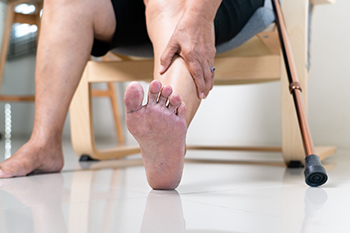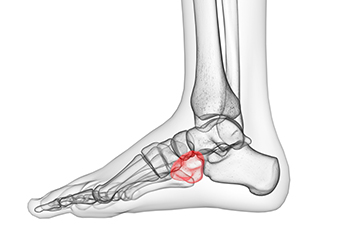Items filtered by date: November 2021
What Is a Gout Flare Up?
Gout is a form of arthritis where excess uric acid in the bloodstream crystallizes on joints in the body. Although other joints in the body can be affected by gout, it typically occurs in the joint of the big toe. Gout flares are intense attacks of pain, inflammation and sometimes redness and warmth in the skin around the affected joint. These flare-ups often occur at night and typically last from 12 hours to a few days. People who are male, overweight, over 40, or who suffer from angina, kidney disease, diabetes, high blood pressure or psoriasis are more at risk of developing gout. Additionally, consuming sugary drinks and foods rich in purines, as well as certain medications are believed to contribute to the formation of this painful condition. If you are experiencing painful flare ups in your big toe joint and fall into one of these categories, make an appointment with a podiatrist. By taking a sample of fluid from the affected toe and performing an examination, they can determine if the cause of your discomfort is gout, and help treat it.
Gout is a foot condition that requires certain treatment and care. If you are seeking treatment, contact Dr. Odin De Los Reyes from Connecticut. Our doctor will treat your foot and ankle needs.
What Is Gout?
Gout is a type of arthritis caused by a buildup of uric acid in the bloodstream. It often develops in the foot, especially the big toe area, although it can manifest in other parts of the body as well. Gout can make walking and standing very painful and is especially common in diabetics and the obese.
People typically get gout because of a poor diet. Genetic predisposition is also a factor. The children of parents who have had gout frequently have a chance of developing it themselves.
Gout can easily be identified by redness and inflammation of the big toe and the surrounding areas of the foot. Other symptoms include extreme fatigue, joint pain, and running high fevers. Sometimes corticosteroid drugs can be prescribed to treat gout, but the best way to combat this disease is to get more exercise and eat a better diet.
If you have any questions please feel free to contact our offices located in Southbury and Farmington, CT . We offer the newest diagnostic and treatment technologies for all your foot and ankle needs.
The Formation of Ingrown Toenails
 When a curved toenail begins to grow into the skin on the sides of the nails, it digs into the skin and the skin grows around it, which results in pain, redness, and swelling. This is known as an ingrown toenail. Ingrown toenails can form due to genetic factors, trauma to the toe, improperly trimmed toenails (make sure they are cut straight across), or shoes that are too tight. If the ingrown toenail is severe enough, it can become infected, which is often indicated by drainage and a bad odor. Patients with ingrown toenails should consult with a podiatrist if they have diabetes, the nail is infected, or they have recurring ingrown toenails. A podiatrist will look to find the best treatment option for the nail (which may include surgery) and treat any potential infection.
When a curved toenail begins to grow into the skin on the sides of the nails, it digs into the skin and the skin grows around it, which results in pain, redness, and swelling. This is known as an ingrown toenail. Ingrown toenails can form due to genetic factors, trauma to the toe, improperly trimmed toenails (make sure they are cut straight across), or shoes that are too tight. If the ingrown toenail is severe enough, it can become infected, which is often indicated by drainage and a bad odor. Patients with ingrown toenails should consult with a podiatrist if they have diabetes, the nail is infected, or they have recurring ingrown toenails. A podiatrist will look to find the best treatment option for the nail (which may include surgery) and treat any potential infection.
Ingrown toenails may initially present themselves as a minor discomfort, but they may progress into an infection in the skin without proper treatment. For more information about ingrown toenails, contact Dr. Odin De Los Reyes of Connecticut. Our doctor can provide the care you need to keep you pain-free and on your feet.
Ingrown Toenails
Ingrown toenails are caused when the corner or side of a toenail grows into the soft flesh surrounding it. They often result in redness, swelling, pain, and in some cases, infection. This condition typically affects the big toe and may recur if it is not treated properly.
Causes
- Improper toenail trimming
- Genetics
- Improper shoe fitting
- Injury from pedicures or nail picking
- Abnormal gait
- Poor hygiene
You are more likely to develop an ingrown toenail if you are obese, have diabetes, arthritis, or have any fungal infection in your nails. Additionally, people who have foot or toe deformities are at a higher risk of developing an ingrown toenail.
Symptoms
Some symptoms of ingrown toenails are redness, swelling, and pain. In rare cases, there may be a yellowish drainage coming from the nail.
Treatment
Ignoring an ingrown toenail can have serious complications. Infections of the nail border can progress to a deeper soft-tissue infection, which can then turn into a bone infection. You should always speak with your podiatrist if you suspect you have an ingrown toenail, especially if you have diabetes or poor circulation.
If you have any questions, please feel free to contact our offices located in Southbury and Farmington, CT . We offer the newest diagnostic and treatment technologies for all your foot care needs.
Gout Pain Can Be Managed
Who Is at Risk for Developing Plantar Fasciitis?
 Plantar fasciitis can occur when the ligament that runs along the bottom of the foot, known as the plantar fascia, becomes inflamed or torn. The most common sign of plantar fasciitis is pain and swelling in the heel that is worse in the morning or after standing for long periods of time. As patients get older, the plantar fascia loses its ability to stretch, and the fat pad of the heel begins to wear. This results in a higher risk of developing plantar fasciitis. Other factors for developing plantar fasciitis include being overweight and having high arches or tight calf muscles. Patients who believe that they have plantar fasciitis should consult with a podiatrist for a proper diagnosis and treatment plan.
Plantar fasciitis can occur when the ligament that runs along the bottom of the foot, known as the plantar fascia, becomes inflamed or torn. The most common sign of plantar fasciitis is pain and swelling in the heel that is worse in the morning or after standing for long periods of time. As patients get older, the plantar fascia loses its ability to stretch, and the fat pad of the heel begins to wear. This results in a higher risk of developing plantar fasciitis. Other factors for developing plantar fasciitis include being overweight and having high arches or tight calf muscles. Patients who believe that they have plantar fasciitis should consult with a podiatrist for a proper diagnosis and treatment plan.
Plantar fasciitis can be very painful and inconvenient. If you are experiencing heel pain or symptoms of plantar fasciitis, contact Dr. Odin De Los Reyes from Connecticut. Our doctor can provide the care you need to keep you pain-free and on your feet.
What Is Plantar Fasciitis?
Plantar fasciitis is the inflammation of the thick band of tissue that runs along the bottom of your foot, known as the plantar fascia, and causes mild to severe heel pain.
What Causes Plantar Fasciitis?
- Excessive running
- Non-supportive shoes
- Overpronation
- Repeated stretching and tearing of the plantar fascia
How Can It Be Treated?
- Conservative measures – anti-inflammatories, ice packs, stretching exercises, physical therapy, orthotic devices
- Shockwave therapy – sound waves are sent to the affected area to facilitate healing and are usually used for chronic cases of plantar fasciitis
- Surgery – usually only used as a last resort when all else fails. The plantar fascia can be surgically detached from the heel
While very treatable, plantar fasciitis is definitely not something that should be ignored. Especially in severe cases, speaking to your doctor right away is highly recommended to avoid complications and severe heel pain. Your podiatrist can work with you to provide the appropriate treatment options tailored to your condition.
If you have any questions please feel free to contact our offices located in Southbury and Farmington, CT . We offer the newest diagnostic and treatment technologies for all your foot and ankle needs.
How Older Adults Can Promote Foot and Ankle Health
With age comes drier skin, brittle nails, decreased cushioning on bones, and even poor circulation. All of these factors can make foot and ankle health challenging. That is why it is important for older adults to be proactive about their foot and ankle health and help avoid problems from occurring. The best thing an older adult can do for their feet is to wear well-made, comfortable shoes that fit properly and offer adequate cushioning and support. Avoid wearing socks that are tight and can cut off circulation. Measure your feet when buying new shoes, because feet can widen with age. Try not to sit for too long without elevating your feet or doing gentle foot and ankle stretches to keep the blood flowing. Trim toenails straight across, but not too short, to avoid them becoming ingrown. Maintain a healthy weight prevent many painful foot conditions. Older adults with diabetes should avoid going barefoot, be sure to examine their feet every day, and check for developing wounds. Finally, older adults—and particularly those with diabetes—should make seeing a podiatrist regularly part of their foot and ankle health regimen.
If you need your feet checked, contact Dr. Odin De Los Reyes of Connecticut. Our doctor will attend to all of your foot and ankle needs and provide you with quality treatment.
Geriatrics and Podiatry
When people age, some common issues that may occur are bone density loss, dry skin, poor circulation, and rough brittle nails. These issues may also affect your foot health if the necessary steps are not taken to alleviate the problems.
It is important to take care of your feet because feet that are injured or diseased can affect your overall health. Having painful feet hinders your ability to do daily activities or may decrease your willingness to do the things that you need to do.
Visiting Your Geriatrician
As we age, health problems become more likely, so it is essential to visit your doctor for check-ups to ensure that you are doing the best you can to take care of your health. It is recommended to check your feet frequently for any possible cuts, bruises, swelling, corns or any other irregularities.
Taking Care of Elderly Feet
Cracked or dry feet can be treated by applying moisturizer often. It is also important not to wear old socks because the older the sock is, the higher the possibility there will be that there is bacteria there. Wear fresh socks and make sure they fit properly.
Proper foot health means that you can have a more active lifestyle and you will not be bogged down by pain. Foot health also leads to good circulation, which is paramount for overall health.
If you have any questions, please feel free to contact our offices located in Southbury and Farmington, CT . We offer the newest diagnostic tools and technology to treat your foot and ankle needs.
Cuboid Bone Displacement
The cuboid bone is cube-shaped and located near the middle of the foot. When this bone is displaced, the resulting condition is known as cuboid syndrome. Cuboid syndrome causes pain and swelling along the side of the affected foot. The pain typically worsens during physical activity and while bearing weight. Cuboid syndrome is often seen following an ankle sprain. If the cuboid bone is displaced, your podiatrist may be able to physically manipulate it back into place with a technique called the “cuboid whip.” Your podiatrist will also be able to perform tests that can rule out other potential causes for your pain, such as a fracture or plantar fasciitis. If you are suffering from foot pain, please seek the care of a podiatrist near you.
Cuboid syndrome, also known as cuboid subluxation, occurs when the joints and ligaments near the cuboid bone in the foot become torn. If you have cuboid syndrome, consult with Dr. Odin De Los Reyes from Connecticut. Our doctor will assess your condition and provide you with quality foot and ankle treatment.
Cuboid syndrome is a common cause of lateral foot pain, which is pain on the outside of the foot. The condition may happen suddenly due to an ankle sprain, or it may develop slowly overtime from repetitive tension through the bone and surrounding structures.
Causes
The most common causes of cuboid syndrome include:
- Injury – The most common cause of this ailment is an ankle sprain.
- Repetitive Strain – Tension placed through the peroneus longus muscle from repetitive activities such as jumping and running may cause excessive traction on the bone causing it to sublux.
- Altered Foot Biomechanics – Most people suffering from cuboid subluxation have flat feet.
Symptoms
A common symptom of cuboid syndrome is pain along the outside of the foot which can be felt in the ankle and toes. This pain may create walking difficulties and may cause those with the condition to walk with a limp.
Diagnosis
Diagnosis of cuboid syndrome is often difficult, and it is often misdiagnosed. X-rays, MRIs and CT scans often fail to properly show the cuboid subluxation. Although there isn’t a specific test used to diagnose cuboid syndrome, your podiatrist will usually check if pain is felt while pressing firmly on the cuboid bone of your foot.
Treatment
Just as the range of causes varies widely, so do treatments. Some more common treatments are ice therapy, rest, exercise, taping, and orthotics.
If you have any questions, please feel free to contact our offices located in Southbury and Farmington, CT . We offer the newest diagnostic and treatment technologies for all your foot care needs.




